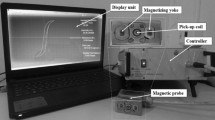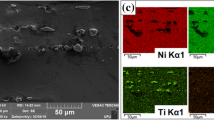Abstract
The present contribution aims to study the combination effects of pre- and post-nitriding grinding and gas nitriding parameters (depth of cut, abrasive type, cooling mode, and nitriding depth) on the material grindability and generated surface integrity of AISI D2 tool steel. As a result, it is shown that grinding with sol-gel abrasive type increases AISI D2 surface hardness before gas nitriding when compared to Al2O3. To remove the brittle white layer, a fine post-nitriding during grinding experiments shows an improved grindability, yet an increase of total and arithmetic roughness with all grinding combination’s parameters. After AISI D2 gas nitriding at 24 and 36 h, using the sol-gel abrasive type and conventional cooling mode, a compressive residual state of stresses was induced for lower depth of cut in grinding. When drawing the evolution of grinding specific energy regarding process parameters, it was possible to distinguish between burned and non-burned surfaces. This has helped to perform comparison of the AISI D2 steel ground surface burning under various grinding conditions after and before nitriding. Moreover, it was observed that thermal cracks appear only on severe grinding with combination of Al2O3 abrasive type and conventional cooling mode.













Similar content being viewed by others
Abbreviations
- de:
-
Grinding wheel diameter (mm)
- b:
-
Grinding width (mm)
- aw :
-
Depth of cut (mm)
- vw :
-
Work speed (m/s)
- vs :
-
Wheel speed (m/s)
- Q’ w :
-
Stock removal rate (mm3/mm.s)
- Ft :
-
Tangential grinding force (N)
- Fn :
-
Normal grinding force (N)
- ec :
-
Specific grinding energy (J/mm3)
- e* c :
-
Critical grinding energy (J/mm3)
- μ:
-
Coefficient of friction
References
Totten GE (2007) Steel Heat Treatment: Metallurgy and Technologies, 2nd edn. Taylors & Francis Group, CRC Press, New York, pp 476–537 665–693
Cho KT, Lee Y-K, Lee WB (2015) Wear behavior of AISI D2 steel by enhanced ion nitriding with atomic attrition. Tribol Int 87:82–90
Limodin N, Verreman Y (2006) Fatigue strength improvement of a 4140 steel by gas nitriding: influence of notch severity. Mater Sci Eng A 435:460–467
Orečný M, Buršák M, Šebek M, Falat L (2016) Influence of hardness, matrix and carbides in combination with Nitridation on abrasive Wear resistance of X210Cr12 tool steel. Metals 6(10):236
Akhtar S, Arif A, Yilbas BS (2010) Evaluation of gas nitriding process with in-process variation of nitriding potential for AISI H13 tool steel. Int J Adv Manuf Technol 47(5–8):687–698
Akhtar SS, Arif AFM, Yilbas BS (2012) Influence of multiple nitriding on the case hardening of H13 tool steel: experimental and numerical investigation. Int J Adv Manuf Technol 58(1–4):57–70
Terres M, Mohamed SB, Sidhom H (2010) Influence of ion nitriding on fatigue strength of low-alloy (42CrMo4) steel: experimental characterization and predictive approach. Int J Fatigue 32(11):1795–1804
Staia MH, Pérez-Delgado Y, Sanchez C, Castro A, Le Bourhis E, Puchi-Cabrera ES (2009) Hardness properties and high-temperature wear behavior of nitrided AISI D2 tool steel, prior and after PAPVD coating. Wear 267(9–10):1452–1461
Cho KT, Song K, Oh SH, Lee YK, Lee WB (2014) Enhanced surface hardening of AISI D2 steel by atomic attrition during ion nitriding. Surf Coat Technol 251:115–121
She D, Yue W, Fu Z, Gu Y, Wang C, Liu J (2013) The effect of nitriding temperature on hardness and microstructure of die steel pre-treated by ultrasonic cold forging technology. Mater Des 49:392–399
Hassani-Gangaraj S, Moridi A, Guagliano M, Ghidini A (2014) Nitriding duration reduction without sacrificing mechanical characteristics and fatigue behavior: the beneficial effect of surface nano-crystallization by prior severe shot peening. Mater Des 55:492–498
Yasavol N, Mahboubi F (2012) The effect of duplex plasma nitriding-oxidizing treatment on the corrosion resistance of AISI 4130 steel. Mater Des 38:59–63
Tong W, Liu C, Wang W, Tao N, Wang Z, Zuo L, He J (2007) Gaseous nitriding of iron with a nanostructured surface layer. Scr Mater 57(6):533–536
Terres MA, Sidhom H (2012) Fatigue life evaluation of 42CrMo4 nitrided steel by local approach: equivalent strain-life-time. Mater Des 33:444–450
Panfil D, Kulka M, Wach P, Michalski J, Przestacki D (2017) Nanomechanical properties of iron nitrides produced on 42CrMo4 steel by controlled gas nitriding and laser heat treatment. J Alloys Compd 706:63–75
Terres MA, Ben Fathallah B, Ghanem A (2017) Effects of surface pre-treatment on the Nitrided layers properties. Am J Mech Ind Eng Am 2(1):41–47
Piccilli MR, Balestrassi PP, Paiva AP, Ferreira JR, Garcia-Diaz A (2011) Crack avoidance in steel piston rings through the optimization of process and gas nitriding parameters. Int J Adv Manuf Technol 56:397–409
Mashreghi AR, Soleimani SMY, Saberifar S (2013) The investigation of wear and corrosion behavior of plasma nitrided DIN 1.2210 cold work tool steel. Mater Des 46:532–538
Fathallah BB, Fredj NB, Sidhom H, Braham C, Ichida Y (2009) Effects of abrasive type cooling mode and peripheral grinding wheel speed on the AISI D2 steel ground surface integrity. Int J Mach Tools Manuf 49(3–4):261–272
Farrahi G, Ghadbeigi H (2006) An investigation into the effect of various surface treatments on fatigue life of a tool steel. J Mater Process Technol 174(1–3):318–324
Terres MA, Laalai N, Sidhom H (2012) Effect of nitriding and shot-peening on the fatigue behavior of 42CrMo4 steel: experimental analysis and predictive approach. Mater Des 35:741–748
Malkin S, Guo C (2007) Thermal analysis of grinding. CIRP Ann 56(2):760–782
Acknowledgements
We are grateful for technical support by F3T Tunisian companies, as they have provided us with gas nitriding for AISI D2 tool steel. Then, cold die steel was performed to deep drawing cold extension dies, punches, and forging material used by SO RE TOL Company.
Author information
Authors and Affiliations
Corresponding author
Additional information
Publisher’s note
Springer Nature remains neutral with regard to jurisdictional claims in published maps and institutional affiliations.
Rights and permissions
About this article
Cite this article
Ben Fathallah, B., Dakhli, C.E. & Terres, M.A. The effect of grinding parameters and gas nitriding depth on the grindability and surface integrity of AISI D2 tool steel. Int J Adv Manuf Technol 104, 1449–1459 (2019). https://doi.org/10.1007/s00170-019-03943-4
Received:
Accepted:
Published:
Issue Date:
DOI: https://doi.org/10.1007/s00170-019-03943-4




